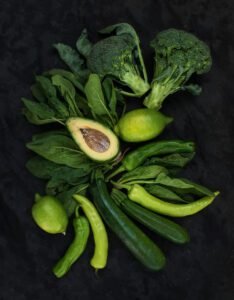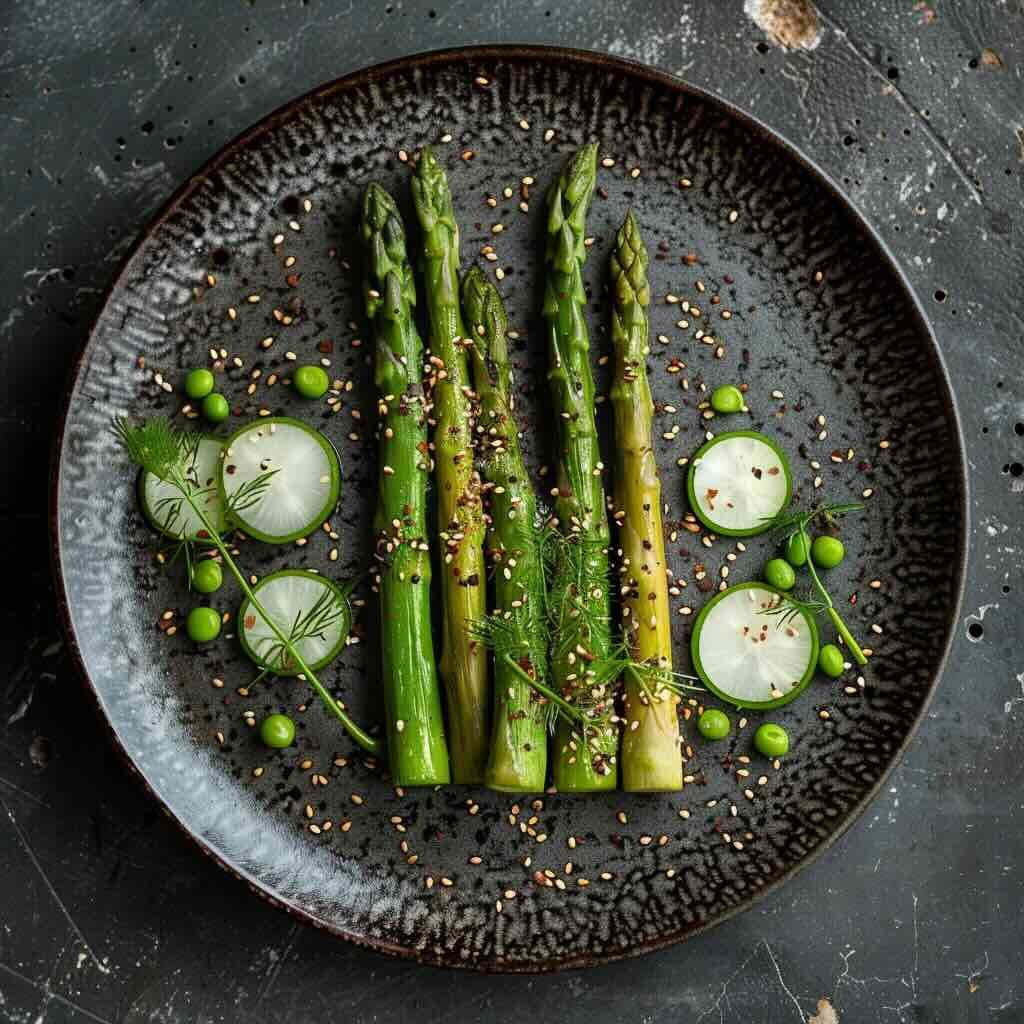The Smoke-Kissed Charm: Discovering Smoked Asparagus
Setting the stage for an epicurean voyage, let us introduce a delightful culinary delight – smoked asparagus. An extraordinary twist on a typical vegetable dish characterised by its distinct smoky flavor, this delicacy perfectly marries earthy asparagus with the rustic savouriness of smoke. The fruitful liaison of these two transforms a simple stalk into an exquisite dish rich in both taste and texture.
Smoked asparagus challenges the traditional steamed version we are all used to, introducing an authentic depth of flavour that tantalises every palate. The smoking process enhances the natural bitterness present in asparagus while also imbuing it with a unique layer of nuanced smoky aroma.
This method is not just about cooking; it’s about augmenting and enriching the inherent flavours that lie dormant within each spear. The result is succulently tender spears enveloped by a gentle, smoky crispness – smoked asparagus is truly an experience that transcends the boundaries of ordinary vegetable dishes.
Green, Lean and Everything In-between – The Crucial Role of Vegetables

As we step away from our exploration of smoked asparagus momentarily, it’s essential to address the broader context – understanding why vegetables are paramount in our diet. Consuming a plethora of vegetables daily lays down solid foundations for robust health due to their nutrient-loaded profiles offering vitamins, minerals and fibre.
Vegetables like asparagus foster many physiological benefits – they fortify your body’s systems, promote heart health, build strong bones and even help combat certain types of cancers. They also contribute to maintaining optimal gut health due to high dietary fibre content that aids digestion and helps maintain weight balance.
In addition to their nutritional prowess, vegetables are exceptionally versatile culinary companions – they can be consumed raw, steamed, sautéed or smoked. The varied methods for vegetable preparation not only maintain interest and excitement in your diet but also allow you to discover different textures and flavours that each method uniquely brings forth.
Incorporating vegetables into your diet is not just about health; it’s about exploring a world of captivating tastes, colours, and textures that elevate your relationship with food. So let us return to our protagonist – the magnificently smoked asparagus – a testament of how versatile and delightful vegetables can truly be.
Transforming Tradition: The Smoky Asparagus Revolution
The usual ways of preparing asparagus – be it roasted, grilled or steamed – are tried and tested pathways to deliciousness. However, entering the realm of smoked asparagus is like delving into an entirely new dimension where tradition meets innovation, giving birth to an unprecedented gastronomic wonder. At its core, smoking manipulates heat and smoke from wood chips to cook the food gently while infusing it with prominent smoky undertones that elevate its natural flavour profile.
In the case of asparagus, this technique gives the vegetable a delectable edge in taste by adding layers of complex smoky flavours while preserving its crisp-tender integrity. The metamorphosis from raw green stalks to delicately charred spears imbued with deep smoky accents is nothing short of culinary artistry.
It evokes a sense of uniqueness that defies conventional norms surrounding vegetable dishes and challenges our taste buds in incredibly exciting ways. This enchanting journey through smoked asparagus narrates more than just a culinary procedure; it signifies an innovative leap in harnessing vegetables’ full potential – proving once again that creativity knows no bounds when coupled with tradition in the broad canvas known as cooking.
Unearthing the Historical Significance and Cultivation of Asparagus

The asparagus, known scientifically as Asparagus officinalis, boasts a rich tapestry of history that is as enthralling as its unique flavor profile. Its origins can be traced back to approximately 2,000 years ago, where it was highly esteemed by the Egyptians, Greeks, and Romans for its delectable taste and purported medicinal properties. The Romans were particularly fond of this verdant delight.
In fact, the Roman gourmet Apicius mentioned asparagus in his renowned cookbook “De Re Coquinaria,” attesting to its culinary value in antiquity. During the Middle Ages, the cultivation of asparagus dwindled somewhat due to its labor-intensive planting process; however, it enjoyed a resurgence during the Renaissance period.
By this time, ingenious horticultural techniques had been developed to blanch the vegetable underground to improve its flavor and ensure a tender texture. This cultivation method involved mounding soil over emerging spears to prevent photosynthesis and consequently keep them white.
In more recent times – during the 19th century – purple and green varieties of asparagus began taking root in Europe after being selectively bred for their coloration. Today’s popular green variety is actually a design of nature – when sunlight hits an emerging spear, it triggers photosynthesis which turns it from white to green.
In terms of cultivation practices today, modern farmers employ both traditional methods (hand-cutting spears) and technologically advanced practices (using specially designed machines) for harvesting purposes. Despite these advancements though, growing asparagus remains an art that requires patience – demanding up to three years from seed sowing until harvestable spears are produced.
The Geographical Footprint: Where Asparagus Grows Best
Moving away from its historical roots, in the contemporary world, asparagus is grown in a variety of geographical regions. Its adaptability and tenacity make it a viable crop across diverse climates and terrains. Today, the majority of the world’s asparagus comes from China, with other significant contributors being Peru, Mexico, and Germany.
However, this resilient plant has found a home in myriad landscapes across the globe. In the United States, Michigan is renowned for its asparagus production due to its sandy soil and cool spring weather conditions that are conducive to growing thick and tender spears.
California also provides an ideal climate for year-round cultivation. In Europe, France holds steadfastly onto traditional cultivation methods, producing “white gold” – white asparagus – which is highly regarded for its creamy texture and delicate flavor notes.
Germany too has established itself as a dominant player in the European market with an impressive output of both white and green varieties. The geographical distribution of asparagus farming demonstrates that while this unique plant may have deep historical roots traced back to ancient civilizations, it continues to propagate its green spears globally – transcending borders and uniting us all by virtue of our shared love for this delicious vegetable.
Nutritional Value of Smoked Asparagus
An In-Depth Analysis of the Nutrient Profile of Asparagus
When discussing the nutritional value of asparagus, one should note that this verdant vegetable is a treasure trove of nutrients. A single serving – roughly 100 grams – provides an abundance of vitamins and minerals vital for our health. It is exceptionally high in Vitamin K, required for blood clotting and bone health.
Additionally, it delivers considerable amounts of Vitamin A, essential for good vision and immune function. Asparagus also offers a multitude of B vitamins including B1 (thiamine), B2 (riboflavin), B3 (niacin), B5 (pantothenic acid) and B6 (pyridoxine).
These are indispensable for maintaining energy levels and brain function. Not only that, but it also contains significant amounts of Vitamin C which fights free radicals and supports a healthy immune system.
Furthermore, asparagus stands out with its high folate content, a nutrient necessary for DNA replication and repair. Also noteworthy are the trace minerals found in asparagus: copper essential for red blood cell production; iron involved in oxygen transport; manganese necessary for metabolism; phosphorus required for bone health; potassium which aids nerve functions and muscle contractions; selenium with antioxidant properties and zinc crucially involved in several body functions.
The Bounty Of Health Benefits Derived From Consuming Asparagus
The rich repository of nutrients that asparagus carries translates into numerous health benefits. The fiber present aids digestion by adding bulk to your diet thus promoting regular bowel movements. It also contributes to heart health by reducing LDL cholesterol levels while increasing HDL cholesterol.
Incorporating asparagus into your diet can support weight loss due to its low calorie content coupled with high fiber which can keep you satiated longer. Moreover, it possesses anti-inflammatory properties attributed to its antioxidant content, making it beneficial for individuals suffering from chronic inflammation such as arthritis.
Asparagus is also known for its diuretic properties, largely due to the amino acid asparagine, which aids in flushing out excess fluid and salt from the body. This can be helpful for people with edema or high blood pressure.
Researchers have also linked asparagus consumption to lower risks of certain cancers due to its rich supply of antioxidants and potential anticancer properties. An additional benefit is that asparagus is a natural source of prebiotics – the nondigestible food ingredients that promote growth and activity of friendly gut bacteria, thereby improving digestive health.
Due to significant amounts of vitamin B9 (folate) and iron, consuming asparagus regularly during pregnancy can help prevent neural tube defects in newborns and combat iron deficiency anemia. Not only does this spear-shaped vegetable add a sophisticated touch to your meals but it also bestows upon an array of nutritional benefits that would make it an excellent addition to any healthy diet.
Introduction to Smoking Foods
An Odyssey Through the Past: The History and Origins of Smoking Foods
The roots of smoking foods trace back to our early ancestors, who discovered that food exposed to the smoke of fire tended to last longer. This was primarily due to the drying effect smoke had on food, which reduced its water content and thus, hindered bacterial growth. Over time, through experimentation and innovation, they realized this practice not only preserved the food but lent it a unique flavor.
Initially, smoking foods was a survival tactic. It allowed early humans to store their precious hunt for later consumption without fearing spoilage.
It is believed that indigenous groups of North America were pioneers in developing more sophisticated smoking techniques. Over centuries, smoking evolved from being a bare necessity to an art form celebrated worldwide for its ability to infuse intricate flavors into food.
Each region developed its distinct style based on available resources and gastronomic preferences. From the rich smoky barbeque culture in Southern United States steeped in tradition and competition, to the elegant smoked salmon integral to Scandinavian cuisine; smoke has made an indelible imprint on global culinary landscape.
In recent years, with an ever-growing interest in diverse cooking techniques and gourmet cuisine, smoking has seen a glorious resurgence. Chefs across the world are experimenting with various types of woods, herbs and even teas like Lapsang Souchong for creating intriguing smoky notes in both traditional and modern dishes.
The Twin Flames: Understanding Hot Smoking Vs Cold Smoking
The art of smoking involves primarily two methods – hot smoking and cold smoking. Hot smoking cooks and flavors your food simultaneously by exposing it directly to heat over controlled low temperatures generally between 225 – 250 degrees Fahrenheit (107-121 degrees Celsius).
This technique imparts a deep smokey flavor and tenderizes the food. Hot smoked foods are ready to eat right off the smoker.
On the other hand, cold smoking is a delicate and more time-consuming process where food is held in an environment kept under 85 degrees Fahrenheit (29 degrees Celsius) and exposed to smoke. It essentially infuses a smoky flavor without cooking the item, hence is often done as a precursor to another cooking method.
Foods like cheese, nuts or fish are commonly cold smoked. Each method results in unique textural and flavor outcomes.
While hot smoking typically yields foods that are moist and flaky with an intense smokiness, cold-smoked items retain their original texture with subtler notes of smoke. Your choice between hot and cold smoking depends on the type of food you’re working with, your desired result and eating habits.
It’s worth noting that both techniques require specific equipment such as a smoker or smoke generator designed for this purpose. The complexity involved in managing temperatures accurately while ensuring ample smoke production makes it quite challenging yet alluring for culinary enthusiasts.
The Smoky Elixir: Benefits and Flavor Profile Achieved Through Smoking
The captivating allure of smoking lies in its ability to transform flavors radically. The process not only imparts a delectable smoky taste but also enhances the innate flavors of foods making them highly palatable.
Smoke penetrates deep into fatty tissues rendering them succulent while forming an appetizing crust on meats or vegetables like our star ingredient – asparagus. Foods bathed in smoke adopt different flavor profiles based on what’s used for generating the smoke – usually hardwoods like hickory, oak or fruitwoods such as apple or cherry wood which each bring their unique aroma to play.
In essence, you’re painting your canvas of flavors with strokes lent by burning wood which indeed adds a rustic charm to the final dish. Aside from its sensory benefits, smoking also offers slow-cooked nutrition.
The method entails cooking foods at lower temperatures for extended periods which help retain their nutritional value better than some other high-heat cooking techniques. Furthermore, smoked food can have longer shelf life, making it a convenient option.
In essence, the richness of tradition and flavor that smoking brings to our culinary repertoire makes it a cherished technique worth mastering. As we delve further into our journey with smoked asparagus, we will harness the power of smoke in creating a gourmet dish extraordinaire.
Preparing for the Perfect Smoky Flavor: Selecting and Prepping Asparagus
The Art of Selecting Asparagus Stalks
Your journey into preparing sumptuous smoked asparagus starts with selecting the appropriate stalks. The beauty of this delicately flavored vegetable lies in its freshness and tenderness.
Seek out stalks that are firm, straight, and have tightly closed tips. The vibrancy of color, preferably a deep green or purplish hue at the tip, is another key indicator of freshness.
Avoid stalks that feel soft or floppy; these are indications that the asparagus is past its prime. It would be wise to shun stalks with open tips and a woody stem as they insinuate age and reduced succulence – two characters you don’t want playing a role in your smoked asparagus production.
Preparation Steps Before Smoking
Once you’ve acquired your perfect batch of fresh asparagus, it’s time to prepare them for smoking. Begin by rinsing under cold water to eliminate any potential dirt or grit. Then, hold each end of your asparagus stalk; bend it until it naturally snaps off towards the base to remove the woody end – nature’s own way of helping us find where toughness ends and tenderness begins.
Pat dry each stalk after rinsing them thoroughly. A little drizzle of olive oil ensures an even cooking process while enhancing flavor during smoking.
Revealing Secrets: The Smoking Process Explained
The Wood Matters: Choosing Wood for Smoking Asparagus
The type of wood used in smoking can dramatically alter the final taste profile achieved on any smoked food item – including our star ingredient here, asparagus. Hardwoods like hickory or oak offer stronger flavors suitable for meats but can overpower vegetables’ delicate flavors.
For asparagus, we recommend using milder woods like apple or cherry. They impart a lightly sweet and subtly smoky flavor that complements and accentuates the natural essence of asparagus without overpowering it.
Your Guide to Smoking Asparagus
Start by preheating your smoker to approximately 225 degrees Fahrenheit. Arranging your prepared asparagus spears on the grate, ensure they’re not overlapping – this promotes even smoking for each stalk.
Smoke the asparagus for around 15-20 minutes. Monitor throughout this process, checking occasionally for desired tenderness.
Mastering the Taste: Achieving Perfectly Smoked Texture and Flavor
The perfect smoked asparagus should have a firm yet tender texture with a rich, smoky flavor enhanced by the vegetable’s intrinsic taste. Achieving this requires a careful balance of temperature control and timing during smoking.
Remember that over-smoking can lead to a loss of moisture, resulting in tough and chewy output. On the flip side, under-smoking results in inadequately cooked stalks with minimal smokey flavour infused.
Savor Flavors: Smoked Asparagus Recipes
Simply Scrumptious: Minimalistic Smoked Asparagus Recipe
The simplest recipe only requires fresh asparagus, some olive oil for drizzling, and salt to taste. Smoke them following our guide above and you have yourself an easy yet impressively flavorful side dish!
A Gourmet’s Delight: Flavor-rich Smoked Asaparagus Recipe
For those seeking indulgence in complexity of flavors can opt for gourmet smoked aspargus recipe where you wrap individual spears in thin slices of prosciutto after drizzling with olive oil and sprinkling some parmesan cheese before smoking.
Eco-Friendly Flavor: Vegan-friendly Smoked Asaparagus Recipe
Vegans need not fret! Simply replace the prosciutto with a vegan-friendly alternative like tofu or seitan, or simply smoke them with a mix of dry herbs and spices for a delicious plant-based treat!
In Good Company: Pairing Suggestions for Smoked Aspargus
Meat Companions: Dishes that Complement Smoked Aspargus
Smoked asparagus makes an excellent accompaniment to meat dishes, particularly grilled meats. Try it alongside a juicy steak or tender grilled chicken for an outdoor cookout vibe.
Sipping Suggestions: Wine Pairing with Smoky Greens
When it comes to wine pairings, consider crisp and light white wines like Sauvignon Blanc or Pinot Grigio. These wines balance the smoky flavor of asparagus while highlighting its unique taste.
Frequently Asked Questions about Smoking Aspargus
To Bite or Not to Bite: Can You Eat the Whole Stalk When It’s Been Smoked?
Yes, after smoking asparagus, the entire stalk becomes tender and is thoroughly edible – from tip to end! The smoking process eliminates any remaining fibrous texture found in raw stalks.
Savoring Freshness: How Long Does Smoked Asparagus Stay Fresh After Being Cooked?
Smoked asparagus is best consumed immediately after cooking when its flavors are most vibrant. However, if you must store it, keep it refrigerated within two hours of cooking and consume within 3-4 days.
The delightfully fresh subtlety of asparagus meets the rich depth of smoking in this culinary exploration. A beautifully healthy vegetable transformed into a gourmet treat through careful selection, preparation, cooking techniques, and perfect pairings. With our comprehensive guide, you’re well on your way to creating your own smoky culinary masterpiece that’s sure to impress.



